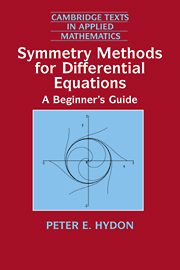Symmetry Methods for Differential Equations
Symmetry is the key to solving differential equations. There are many well-known techniques for obtaining exact solutions, but most of them are special cases of a few powerful symmetry methods. Furthermore, these methods can be applied to differential equations of an unfamiliar type; they do not rely on special 'tricks'. Instead, a given differential equation is forced to reveal its symmetries, which are then used to construct exact solutions. This book is a straightforward introduction to the subject, and is aimed at applied mathematicians, physicists, and engineers. The presentation is informal, using many worked examples to illustrate the main symmetry methods. It is written at a level suitable for postgraduates and advanced undergraduates, and is designed to enable the reader to master the main techniques quickly and easily. The book contains methods that have not previously appeared in a text. These include methods for obtaining discrete symmetries and integrating factors.
- Written in an informal style but mathematically rigorous
- Suitable for undergraduate courses
- Designed to enable the reader to master the main techniques quickly and easily
Reviews & endorsements
"[A] valuable addition to the bookshelf for both the beginner and research worker in the field." Mathematical Geology
"Throughout the text numerous examples are worked out in detail and the exercises have been well chosen. This is the most readable text on this material I have seen and I would recommend the book for self-study." Mathematical Reviews
Product details
January 2000Paperback
9780521497862
228 pages
230 × 153 × 26 mm
0.42kg
8 b/w illus.
Available
Table of Contents
- 1. Introduction to symmetries
- 1.1. Symmetries of planar objects
- 1.2. Symmetries of the simplest ODE
- 1.3. The symmetry condition for first-order ODEs
- 1.4. Lie symmetries solve first-order ODEs
- 2. Lie symmetries of first order ODEs
- 2.1. The action of Lie symmetries on the plane
- 2.2. Canonical coordinates
- 2.3. How to solve ODEs with Lie symmetries
- 2.4. The linearized symmetry condition
- 2.5. Symmetries and standard methods
- 2.6. The infinitesimal generator
- 3. How to find Lie point symmetries of ODEs
- 3.1 The symmetry condition. 3.2. The determining equations for Lie point symmetries
- 3.3. Linear ODEs
- 3.4. Justification of the symmetry condition
- 4. How to use a one-parameter Lie group
- 4.1. Reduction of order using canonical coordinates
- 4.2. Variational symmetries
- 4.3. Invariant solutions
- 5. Lie symmetries with several parameters
- 5.1. Differential invariants and reduction of order
- 5.2. The Lie algebra of point symmetry generators
- 5.3. Stepwise integration of ODEs
- 6. Solution of ODEs with multi-parameter Lie groups
- 6.1 The basic method: exploiting solvability
- 6.2. New symmetries obtained during reduction
- 6.3. Integration of third-order ODEs with sl(2)
- 7. Techniques based on first integrals
- 7.1. First integrals derived from symmetries
- 7.2. Contact symmetries and dynamical symmetries
- 7.3. Integrating factors
- 7.4. Systems of ODEs
- 8. How to obtain Lie point symmetries of PDEs
- 8.1. Scalar PDEs with two dependent variables
- 8.2. The linearized symmetry condition for general PDEs
- 8.3. Finding symmetries by computer algebra
- 9. Methods for obtaining exact solutions of PDEs
- 9.1. Group-invariant solutions
- 9.2. New solutions from known ones
- 9.3. Nonclassical symmetries
- 10. Classification of invariant solutions
- 10.1. Equivalence of invariant solutions
- 10.2. How to classify symmetry generators
- 10.3. Optimal systems of invariant solutions
- 11. Discrete symmetries
- 11.1. Some uses of discrete symmetries
- 11.2. How to obtain discrete symmetries from Lie symmetries
- 11.3. Classification of discrete symmetries
- 11.4. Examples.







